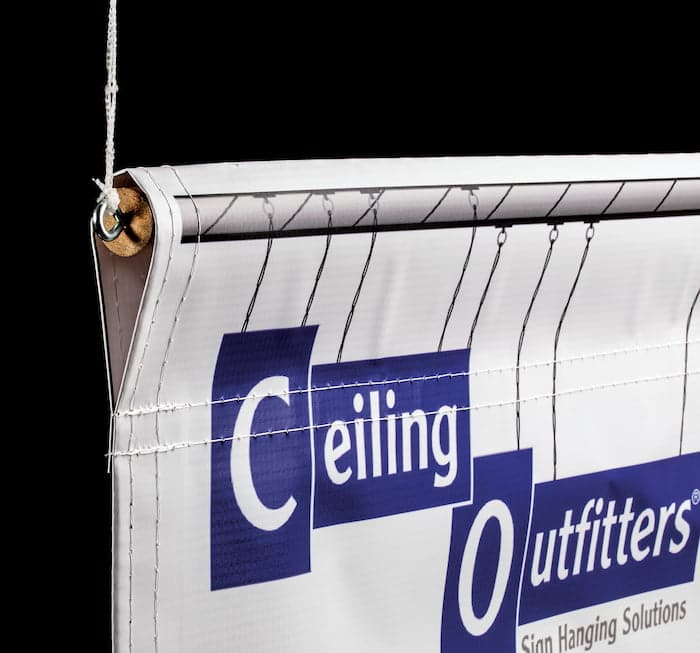
We regularly receive calls asking us how best to hang a sign made with a built-in rod pocket. Rod pockets, also called pole-pockets or pole sleeves, are sewn into the top and sometimes the bottom edges of vinyl and fabric signs and banners. Rod pockets hide the hanging mechanism (the rod) for a more professional appearance for the graphic.
In this article, we are going to discuss the types of inserts for a rod pocket and the hardware you need to hang it from the ceiling or a window frame. Solutions from Ceiling Outfitters® include all the hardware you need to connect the finished sign to a variety of ceilings.
Be sure to work with your sign shop to determine the insert size for the pocket.

Banner with Wooden Dowel Inserted

Banner with Steel Conduit Inserted
Jump to your section:
- Rod Pockets in Vinyl Banners
- Using A Wooden Rod Insert
- Joining Two Lengths of Wood Closet Rods
- Rod Pockets for Fabric Signs
- Using Steel Conduit Insert
- LoopLine Connecting Cord
- Connecting to Traditional Ceilings
- Attaching to Unistrut
- Attaching to a Finished Ceiling
- Attaching to a Wood Ceiling
- Attaching to Aluminum Window Frames
Rod Pockets in Vinyl Banners
Many signs or banners made from vinyl use a rod pocket to provide a hanging point for connecting the sign to the ceiling. Consider adding a rod pocket to the bottom of the vinyl material to stabilize and weigh down the sign minimizing banner sway while keeping the printed surface flat for easy reading of the content.
Wood dowels should be no less than 1 inch in diameter and make ideal inserts. If you need a larger wood dowel, look at wood closet rods. Steel conduit is also a viable option to use as an insert. We do not recommend using PVC pipe as a solution because the tube will droop or bow.
Using A Wooden Rod Insert
A wooden dowel is an ideal insert for the Rod Pocket and is easy to work with. Your local hardware store carries a variety of wood closet rods or dowels. The minimum recommended diameter of the rod is 1 inch. Thinner-diameter wood will bow, causing the sign to droop in the middle.
Add an eye screw to each end of the wood dowel as the connection point for attaching the cord to the ceiling connector. Pre-drill a hole at each end of the rod for the eye screw using a drill bit slightly smaller than the threads of the eye screw. This eliminates or minimizes wood splintering.

Drill Hole in Dowel for Eye Screw

Wooden Dowel with Eye Screw Attached
Joining Two Lengths of Wood Closet Rods
For off-size and wide banners, wooden dowels can easily be joined together with a double screw. To maintain the structural integrity of the joined rods, it is essential to support the joint, add an attachment cord at each joint, and connect to a ceiling clip. As mentioned above, pre-drill the holes for the double screw to ensure a high fit and to keep the wood from possibly splintering.

Double End Screw

Joining Two Dowels with Double Screw

Double End Screw in One End of Dowel(1)
Rod Pockets for Fabric Signs
Everything discussed above is equally applicable when choosing a lightweight fabric for your sign. You will want to add a bottom rod pocket for stabilization.
Using Steel Conduit Insert
Steel electrical conduit is another insert for your rod pocket. Your local DIY center, again, is an ideal source for conduit. This is a heavier option than a wood dowel and based on the size and weight of the banner, and where you hang it, conduit may be the best solution for a stable presentation.
LoopLine Connecting Cord
LoopLine™ is the best connecting cord on the market and, when appropriately used, ensures the sign hangs level. LoopLine is a woven line of 2-inch-long repeating loops. The sign hangs level when each pair of connecting cords are cut with the same number of loops. In addition, connecting LoopLine first to the ceiling clip and then to the banner is made without tying a knot. Simply loop the line back through itself for a stronger connection than a knot. Here is a link to our How to Use LoopLine on our website.
Since the conduit does not have a closed-end, you can still use LoopLine to connect steel conduit to the ceiling. Determine the distance from the ceiling to the top of the banner and multiply by two, then add the length of the conduit for the length of LoopLine. Cut one length of properly measured LoopLine and run it through the conduit so the conduit sits centered on the line, and then connect each end of LoopLine to the ceiling clip.
Connecting to Traditional Ceilings
Our Super ClikMagnet™ is the best solution on the market for connecting signs and banners to a ceiling. It works with any steel or ferrous surface. With up to a 10 lb. pull, Super ClikMagnets are strong enough for most applications and easily attach to drop ceiling T-bar, open-beam ceiling girders, and metal struts like Unistrut® and Telestrut®.
Attaching to Unistrut
Our ClikMagnet™ product is the best solution on the market for attaching signs to perforated square tubing like Telestrut® or pre-formed open channels with perforations like Unistrut®. The design of the rectangular-shaped Super ClikMagnet spans the perforations creating a strong connecting point. The Round Red ClikMagnet, our strongest offering, fits well between the perforations.
Attaching to a Finished Ceiling
A closed-eye or a j-hook screw with at least a 2” threaded shaft is an excellent solution for attaching signs to finished ceilings like drywall or wood.
When hanging from drywall, use E-Z Anchor-type products for a solid connection. LoopLine connecting cord easily attaches to the ceiling and the sign connectors.

Insertion of J-Hook in Drywall Anchor with LoopLine connecting cord.
Attaching to a Wood Ceiling
A closed eye-hook or a j-hook screw with at least a 2” threaded shaft is an excellent solution for attaching signs to finished ceilings like wood. You can source these at your DIY center. When hanging from drywall, use an E-Z Anchor type product for a solid connection.
Attaching to Aluminum Window Frames
We offer a metal plate that attaches to the top surface of an aluminum window frame to receive the ClikMagnet. There is a hole in the middle of the plate for mechanically fastening the plate to the aluminum frame. A high-bond 3M adhesive pad is also installed on the plate as an alternative fastening method. Be sure and follow the instructions included with the plate.

Metal Plate
About Ceiling Outfitters®
Since 2007, Ceiling Outfitters® has partnered with over 2,000 organizations and 22,000 stores nationally within the retail, manufacturing, education, and hospitality industries. Ceiling space and storefront windows are optimal visual display locations, and we help customers utilize these areas safely, quickly, easily, and more economically.
We are the master USA distributor of the Clik-Clik™ family of products, the premier magnetic hanging system that transforms the ceiling eco-system into a workable location for strategic placement of ceiling signs and displays and helps employees suspend items without a ladder or lifting device.





